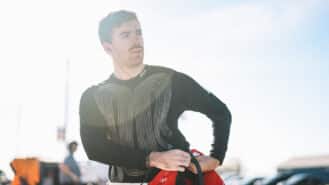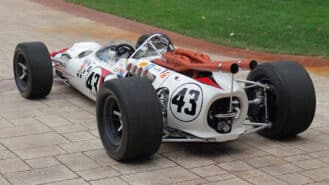
A ‘New Nige’? Foster focused on becoming next British IndyCar star
Louis Foster starts his IndyCar journey this weekend in St Petersburg – can he emulate other British heroes like Nigel Mansell and Dan Wheldon?
It’s probably happened before and since in motor racing somewhere around the world, but the most spectacular last to first performance I’ve ever witnessed took place on the Milwaukee Mile in June of 1981 when Mike Mosley drove All American Racers’ unique Eagle-Chevy from the back of the grid to win.
Mosley performed his feat aboard what was known as the Boundary Layer Adhesion Technology (BLAT) Eagle-Chevy first raced by AAR in 1980. The car is Dan Gurney’s favourite Eagle Indycar because it’s the definition of All American Racers. The car was completely different from conventional thinking, highly innovative in a number of ways, and – the ultimate compliment – it was so successful that it was banned.
Most CART teams ran turbocharged Cosworth DFX V8s in those days but AAR typically went a different route developing its own normally-aspirated Chevrolet stock-block engines built around Donovan aluminum blocks. The Eagle chassis was completely unlike the other top cars of the time from Penske, Chaparral, Coyote, March, Wildcat and Phoenix. Everyone else was in the midst of developing classic, ground-effect cars based on the Lotus 79 concept with underwings or ‘tunnels’ creating a low pressure area under the car.
But AAR found a different way to create downforce. Using the BLAT technique, Dan and engineers John Ward and Trevor Harris produced a car that was at least and maybe more effective than the traditional ground-effect cars.
Compared to its competitors the Eagle presented a very different nose to the wind and also enjoyed a strikingly different overall shape. Instead of ducting air underneath the car into an enclosed venturi or underwing in the traditional ground-effect method, the BLAT concept involved a twin vortex generating shape which was linked to the trailing edge of the rear bodywork, wing and a very efficient cooling system exhaust. The routing of the engine exhaust system added further energy and downforce to the airflow, and variants of this concept have been used more recently in Formula 1.
Sure enough, the maverick Eagle-Chevy package was entirely competitive with the turbo Cosworth-powered opposition in 1981. Dan had also sold Pepsi-Cola on sponsoring the team and after five or six tough years things were looking good for a fresh start for AAR. At Indianapolis Mosley and the Eagle were quick from the start of practice and attracted plenty of attention from the other teams who started complaining about the car’s legality.
Mosley qualified second for the 500, sharing the front row with Bobby Unser’s Penske-Cosworth and AJ Foyt’s Coyote-Cosworth, but he was the race’s first retirement after just 16 laps with an oil leak. At Milwaukee the following week there was more bad luck when Mosley started last after missing qualifying because of an engine failure. Mosley had to start from the back of the field, 25th, but as soon as the green flag waved he began to motor to the front. Incredibly, he passed everyone and went on to win as he pleased by over a lap from Kevin Cogan and Mario Andretti.
“Mike just picked ‘em off one at a time,” Gurney recalls. “He passed them on the inside or the outside. In his own inimitable fashion Mike just wore ‘em down and smoked ‘em. It was a phenomenal display and really, on that day, we had no challenge. We were mighty stoked. Milwaukee was something you don’t see very often. That was a very memorable win.”
Mosley came up through the tough school of dirt ovals and sprint cars. During his career Mosley won four other IndyCar races, all on ovals. Sadly, in March of 1984, he was killed in a road accident.
“They didn’t come any better than Mike on an oval,” Gurney remarks. “He was a very gifted driver. Mike could achieve a great deal on an oval. He was quiet, almost like a librarian, but he was very, very good on ovals. Probably if he had more experience on road circuits he might have done very well there too.”
Mosley also led the Michigan 500 two months later but missed a shift on a restart and blew his engine. While Mosley drove the car in oval races, Dan put Can-Am drivers Rocky Moran and Geoff Brabham into the car for the road races. Moran led at Watkins Glen before a refueling kerfuffle and Brabham qualified on the pole at Riverside and also was on the outside of the front row in Mexico City.
At Riverside, Brabham ran away from the field until his first pitstop when the left rear wheel nut was cross-threaded and jammed partway on so that the wheel couldn’t be tightened or removed, ending Brabham’s race.
The Eagle’s success prompted other top teams like Penske and Truesports to build experimental Chevy-powered cars.
Suggestions were made that it would become necessary to have turbo engines for ovals and stock-blocks for road courses, therefore pushing up costs. Eventually, CART solved what they perceived as a problem by writing first the BLAT aero concept and then aluminum stock-block-based engines out of the rulebook.
“The powers-that-be didn’t understand it and didn’t like the fact that it humbled them,” Dan observes. “Therefore, they took the political route and changed the rules on some half-baked concept. There was no precedent or legitimate reason for doing it that way. It was just a strong-arm deal that took what was a very promising American concept and ruled it out. It was another lesson in majority rules.”
Dan and many others regard that ruling as the beginning of ‘spec’ car racing. Henceforth, the layout of an Indycar, including the aerodynamic package, was essentially defined by the rule book. F1 has gone in a similar direction, of course, strictly defining for many years the general parameters of chassis, aerodynamics and engine design.
Read more on IndyCar racing
Ganassi, Penske and Andretti in 2014
The state of IndyCar
Scott Dixon wins his third IndyCar title
“It put a huge damper on creativity and what I think the fans want to see, and still would love to see today,” Dan remarks. “But it didn’t matter. A few powerful guys knew it was good for them. They didn’t care what was good for the sport. All the creativity that went into that car/engine package was wiped out because it was too good. They said we don’t want to go down your path and build cars and engines like that, and we have the power to make the rules.”
AAR bought and raced March-Cosworths for a few years but Gurney’s enthusiasm for Indycar racing had been reduced and he switched to IMSA’s GTP series where the team was very successful, winning two championships and 21 races with John Ward-designed Toyota GTP cars. More recently, only two years ago AAR built the prototype DeltaWing which incorporated more than a little of the aerodynamic thinking that went into the remarkable BLAT Eagle.

Louis Foster starts his IndyCar journey this weekend in St Petersburg – can he emulate other British heroes like Nigel Mansell and Dan Wheldon?

Myles Rowe has rocketed through IndyCar's junior ladder with a story like no other – he tells James Elson why this upcoming year is more important than ever

Drive to Survive star Will Buxton has made the jump across the Atlantic to front Fox's new IndyCar coverage – he explained to James Elson why he thinks the championship is the most exciting series out there

Jackie Stewart's Lola-Ford IndyCar that failed laps from victory in the 1966 Indy 500 was the star lot in a 16-car auction, selling for $715,000